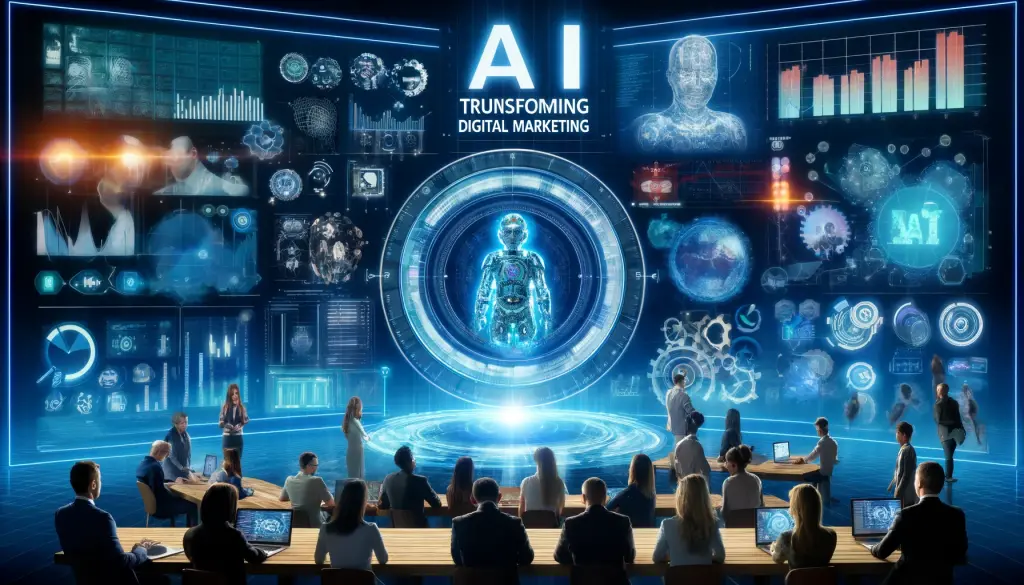The intertwining of artificial intelligence (AI) and environmental sustainability represents a pivotal juncture in our quest to mitigate ecological degradation and foster a healthier planet. In an era marked by rapid technological advancement and growing environmental concerns, the potential of AI to drive sustainable practices is both immense and imperative. This emerging synergy aims to leverage the computational power and analytical precision of AI to address complex environmental challenges, from climate change and biodiversity loss to pollution control and resource conservation.
AI’s role in environmental sustainability is multifaceted, offering tools for better monitoring, understanding, and managing the Earth’s ecosystems. By processing vast datasets and generating predictive insights, AI technologies can help us foresee environmental trends, optimize resource use, and implement effective conservation strategies. For instance, machine learning algorithms can predict weather patterns and climate phenomena, aiding in disaster preparedness and mitigation efforts. Similarly, AI-driven systems are revolutionizing waste management, energy efficiency, and pollution control, showcasing a promising path towards a sustainable future.
However, integrating AI into environmental efforts is not without challenges. Questions regarding the ethical use of technology, its environmental footprint, and the need for equitable access and implementation arise. As we delve into this intricate nexus of AI and environmental sustainability, it is crucial to navigate these challenges thoughtfully, ensuring that technological advancements contribute positively to our ecological well-being and do not exacerbate existing problems.
In this article, we will explore how AI is shaping the landscape of environmental sustainability, highlighting innovative solutions and the hurdles encountered along the way. The journey of merging AI with ecological goals offers a fascinating glimpse into a future where technology and nature coalesce to forge a sustainable and thriving planet.
AI in Environmental Monitoring and Management
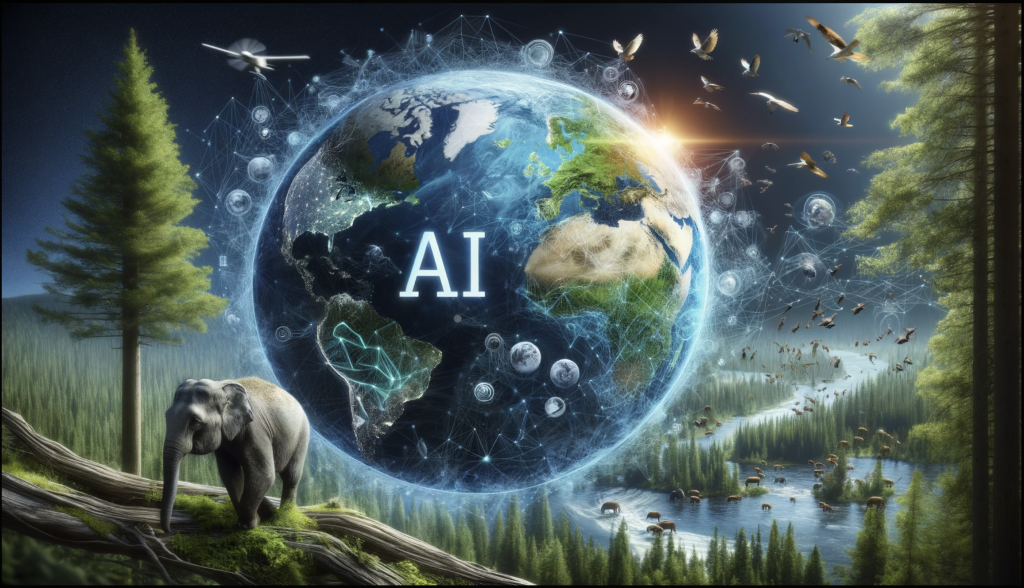
Artificial Intelligence (AI) has become a transformative force in environmental monitoring and management, providing innovative tools to tackle ecological challenges with unprecedented precision and efficiency. Here’s how AI applications are making a difference in various domains:
AI in Climate Modeling
AI enhances climate modeling by analyzing complex datasets to predict future climate conditions. Machine learning algorithms process vast amounts of data from satellite images, weather stations, and ocean buoys to model climate patterns and predict changes over time. These models are crucial for understanding potential climate scenarios and aiding policymakers in crafting informed climate adaptation and mitigation strategies.
Wildlife Protection
In wildlife protection, AI is a game-changer. Technologies like AI-powered drones and camera traps are deployed in natural habitats to monitor wildlife populations, track endangered species, and detect poachers in real-time. For example, the AI system “PAWS” (Protection Assistant for Wildlife Security) has been used to predict poaching patterns and optimize patrol routes in protected areas, significantly aiding in the conservation of species like tigers and elephants.
Pollution Tracking
AI plays a vital role in monitoring and managing environmental pollution. By analyzing data from sensors and satellites, AI systems can identify pollution sources, monitor air and water quality, and predict pollution spread patterns. This capability is critical for addressing urban air pollution and industrial emissions, enabling authorities to take timely action to protect public health and the environment.
Case Studies
- Monitoring Deforestation: In the Amazon rainforest, AI technologies have been implemented to detect illegal deforestation activities. Satellite imagery combined with AI algorithms can swiftly identify changes in forest cover, alerting conservationists and law enforcement to areas of concern. This real-time monitoring is essential for preventing illegal logging and protecting the rainforest’s biodiversity.
- Managing Water Resources: AI is revolutionizing water management through predictive analytics and smart infrastructure. In California, AI-driven systems are used to analyze weather data, soil moisture, and water usage to optimize irrigation in agriculture, significantly reducing water waste and improving crop yields.
- Predicting Natural Disasters: AI models are increasingly used for early warning of natural disasters like hurricanes, floods, and earthquakes. By processing seismic data, atmospheric conditions, and historical disaster patterns, AI can predict the likelihood and impact of such events, enabling better preparedness and minimizing potential damage.
AI-Driven Solutions for Climate Change
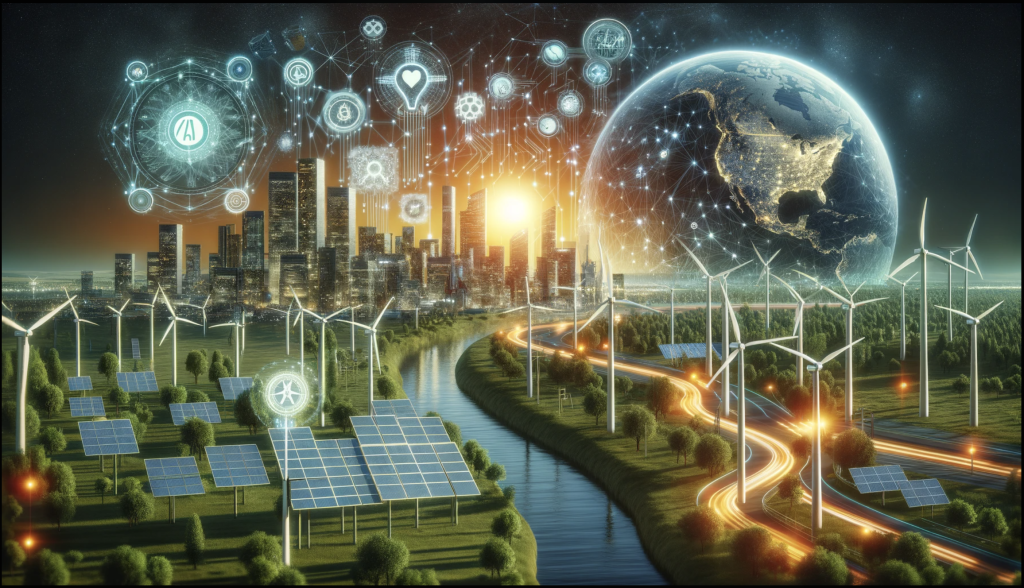
Artificial intelligence (AI) is at the forefront of the battle against climate change, offering innovative solutions to reduce carbon footprints and enhance sustainability. AI’s contribution extends across various domains, from smart energy grids to renewable energy optimization and carbon capture technologies.
Smart Energy Grids
Smart energy grids, powered by AI, are transforming the way we consume and manage electricity. These grids use AI algorithms to predict energy demand and supply, balance load, and integrate renewable energy sources efficiently. By analyzing data from sensors and meters across the grid, AI can optimize energy distribution, reduce waste, and lower greenhouse gas emissions. This real-time management of energy flows helps in minimizing reliance on fossil fuels and supports the transition to cleaner energy sources.
Optimizing Renewable Energy Production
AI significantly contributes to the renewable energy sector by optimizing the production and integration of solar, wind, and other renewable resources. Through predictive analytics, AI can forecast weather conditions, assess the variability of renewable energy sources, and manage energy production accordingly. For example, AI-driven systems can predict solar irradiance and wind patterns, helping to maximize the output of solar panels and wind turbines. This optimization ensures a steady supply of renewable energy and facilitates its integration into the power grid.
Enhancing Energy Storage Solutions
Energy storage is crucial for bridging the gap between energy supply and demand, especially with the intermittent nature of renewable sources. AI enhances energy storage systems by predicting the best times to store or release energy, thereby optimizing the use of batteries and other storage technologies. This not only improves the efficiency of renewable energy utilization but also stabilizes the grid and reduces the need for traditional power plants.
AI in Carbon Capture and Sequestration
AI is playing a pivotal role in advancing carbon capture and sequestration (CCS) technologies. By analyzing data from CCS processes, AI can optimize the capture of CO2 emissions from industrial sources and power plants, improve the efficiency of sequestration methods, and monitor the long-term storage of carbon underground. AI algorithms can identify the most effective techniques for capturing CO2, predict the performance of sequestration sites, and ensure the safe and permanent storage of carbon, thereby contributing to the reduction of atmospheric CO2 levels.
AI in Waste Management and Recycling
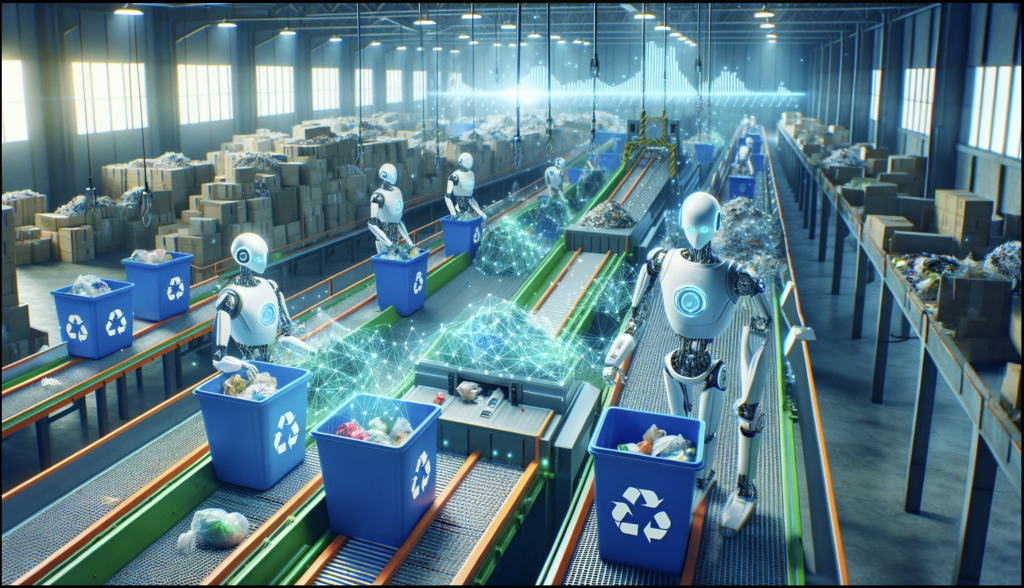
Artificial Intelligence (AI) is significantly transforming the waste management and recycling industry, introducing smarter, more efficient processes to reduce waste and improve recycling rates. Here’s how AI is driving innovation in this sector:
Smarter Recycling Processes
AI systems are being deployed to enhance the recycling process, making it more efficient and effective. These systems can quickly identify and sort recyclable materials from waste streams, reducing contamination and increasing the amount of materials that can be recycled. For example, AI-powered sorting machines use cameras and sensors to detect different types of materials on a conveyor belt, sorting them accurately at high speeds. This technology improves the purity of recycled materials, making them more valuable and easier to process.
Waste Sorting and Reduction Strategies
AI plays a crucial role in waste reduction by optimizing collection routes and schedules, reducing operational costs, and minimizing the carbon footprint of waste collection services. Advanced analytics can predict waste generation patterns, helping municipalities and waste management companies to tailor their services accordingly. By analyzing data from waste collection points, AI can optimize routes and pick-up schedules, ensuring trucks are fully loaded and reducing unnecessary trips.
AI-powered Robots in Recycling
In recycling facilities, AI-powered robots are becoming increasingly common. These robots, equipped with sophisticated vision systems and machine learning algorithms, can identify and separate different materials at a speed and accuracy that surpass human capabilities. For instance, robots equipped with AI can differentiate between types of plastics, glass, and metals, sorting them into separate streams for recycling. This not only increases efficiency but also supports the circular economy by ensuring materials are reused and recycled to their maximum potential.
Managing Electronic Waste (E-Waste)
E-waste, one of the fastest-growing waste streams, poses significant environmental and health challenges. AI technologies are being used to tackle the e-waste crisis by enhancing the efficiency of e-waste recycling processes. AI can help in identifying and separating valuable components from electronic devices, such as metals and rare earth elements, facilitating their recovery and reuse. This not only prevents hazardous materials from ending up in landfills but also supports the recycling of precious resources.
Ethical and Environmental Considerations of AI
As artificial intelligence (AI) becomes increasingly integrated into various aspects of society and the economy, it is important to consider the ethical and environmental implications of its use. One of the most pressing concerns is the carbon footprint associated with training large AI models and running extensive computational processes.

Carbon Footprint of AI
Training sophisticated AI models requires significant computational resources, often entailing the use of large data centers that consume vast amounts of electricity. This energy consumption, especially if sourced from non-renewable energy, contributes to greenhouse gas emissions and has a notable environmental impact. For example, the process of training a single AI model can emit as much carbon dioxide as five cars over their entire lifetimes. As AI technologies advance and become more complex, the energy requirements and associated emissions could increase, raising concerns about the sustainability of current AI practices.
Balancing Innovation and Environmental Impact
The challenge lies in balancing the benefits of AI-driven innovations with their environmental footprint. While AI can contribute significantly to solving environmental issues, such as optimizing energy use or reducing waste, the energy-intensive nature of AI systems themselves must be addressed. This paradox necessitates a shift towards more sustainable AI practices, including:
- Improving Energy Efficiency: Developing more energy-efficient algorithms and computational methods to reduce the overall energy consumption of AI processes.
- Utilizing Renewable Energy: Ensuring that data centers and computational resources used for AI training and operations are powered by renewable energy sources to minimize carbon emissions.
- Carbon Offsetting: Implementing carbon offsetting measures for the emissions that cannot be eliminated, such as investing in reforestation or renewable energy projects.
Sustainable AI Practices
To ensure that AI contributes positively to environmental sustainability, it is crucial to adopt sustainable AI practices. This includes the responsible design, development, and deployment of AI systems with consideration for their life cycle environmental impact. Policymakers, researchers, and industry leaders must work together to establish guidelines and standards that promote the ethical use of AI, ensuring that it supports global sustainability goals rather than undermining them.
Challenges in Merging AI with Environmental Goals
While AI presents transformative potential for environmental sustainability, integrating these technologies with ecological objectives faces several challenges. Understanding these obstacles is crucial for developing effective strategies to harness AI’s full potential in serving environmental goals.
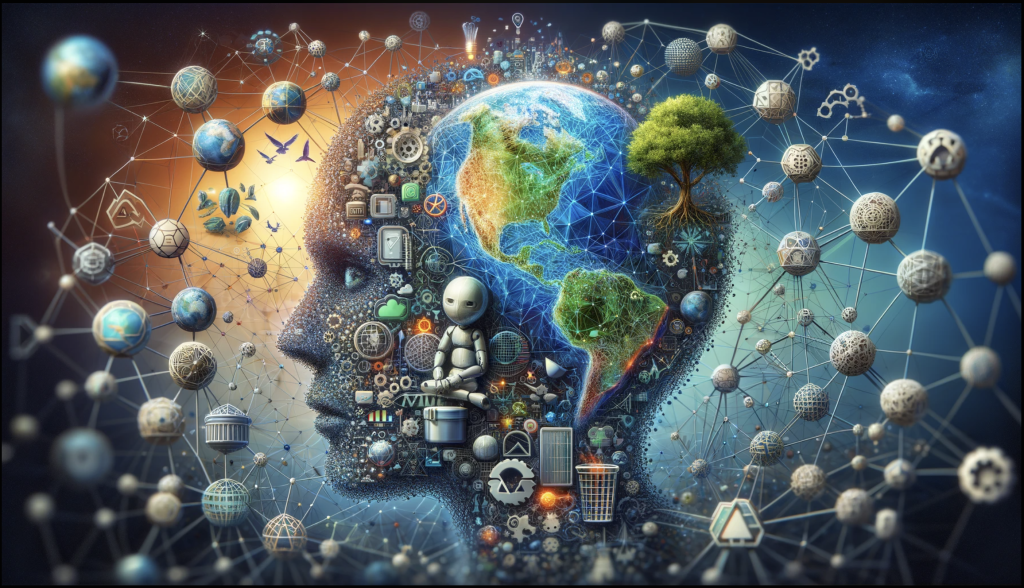
Technical and Infrastructural Hurdles
- Data Accessibility and Quality: High-quality, comprehensive data is fundamental for training effective AI models. However, in the environmental sector, consistent and detailed data can be scarce or difficult to access, limiting the effectiveness of AI solutions.
- Infrastructure Requirements: Implementing AI solutions often requires substantial computational resources and advanced technological infrastructure. In many regions, particularly in developing countries, such infrastructure is lacking, impeding the deployment of AI-driven environmental solutions.
- Integration with Existing Systems: Many environmental management systems are outdated and not designed to integrate with advanced AI technologies. Overcoming this requires significant investment in system upgrades and modifications.
Socioeconomic Barriers
- Investment Needs: Developing and deploying AI solutions for environmental sustainability requires significant financial investment. Securing this funding can be challenging, especially in sectors or regions where the economic benefits of such investments are not immediately apparent.
- Education and Training: There is a need for skilled professionals who can design, implement, and manage AI systems for environmental purposes. This necessitates comprehensive education and training programs to build expertise in both AI and environmental science.
- Policy and Regulation: Effective policy frameworks are essential to guide the development and implementation of AI in a way that aligns with environmental goals. Creating policies that encourage sustainable AI practices while preventing negative consequences, such as job displacement or increased inequality, is a complex challenge.
Bridging the Gap
To successfully merge AI with environmental goals, stakeholders must address these challenges through collaborative efforts, innovative policies, and strategic investments. Developing open data initiatives, enhancing technological infrastructure, and fostering cross-sector partnerships are crucial steps toward realizing the environmental benefits of AI. Additionally, promoting education and creating supportive policy environments can help to mitigate the socioeconomic barriers and ensure that AI advancements contribute positively to environmental sustainability.
The Future of AI in Environmental Sustainability
The future of AI in environmental sustainability is poised at the crossroads of innovation and collaboration. As we venture into this new era, emerging AI technologies promise to revolutionize our approach to ecological preservation and resource management. This section explores the potential impacts of these technologies and the critical role of interdisciplinary collaboration.
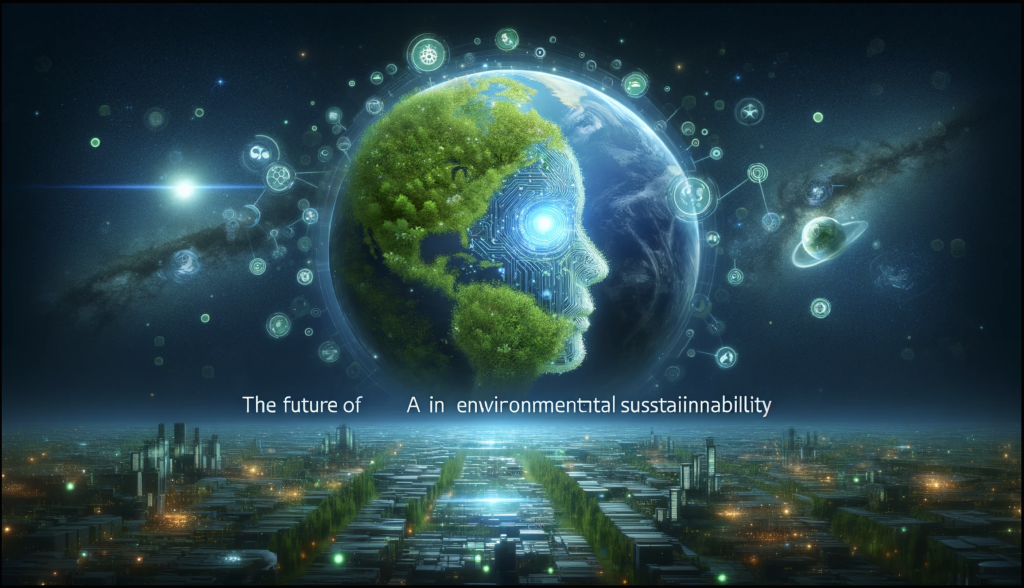
Predictions on Emerging AI Technologies
- Enhanced Climate Prediction Models: AI is expected to bring about more accurate and granular climate prediction models, enabling better preparation and response to climate-related disasters.
- Autonomous Environmental Monitoring Systems: AI-driven drones and satellite imaging will provide real-time, comprehensive data on environmental changes, leading to more effective conservation strategies.
- Smart Agriculture: AI will continue to transform agriculture through precision farming techniques, optimizing resource use and increasing yields while minimizing environmental impacts.
- Energy Efficiency Optimization: AI will be integral in managing and optimizing energy consumption, contributing significantly to the reduction of carbon footprints in residential, commercial, and industrial sectors.
- Biological Diversity Mapping and Protection: AI will aid in mapping and monitoring biodiversity, providing vital data to protect endangered species and their habitats.
Importance of Interdisciplinary Collaboration
The full potential of AI in environmental sustainability can only be harnessed through interdisciplinary collaboration:
- Technologists and Environmental Scientists: Collaborative efforts between AI experts and environmental scientists are crucial for developing solutions that are scientifically sound and technologically advanced. These collaborations can lead to the creation of AI systems that are not only innovative but also grounded in ecological realities.
- Policy Makers: Policymakers play a critical role in shaping the regulatory landscape for the ethical and effective use of AI in sustainability efforts. By working together with technologists and scientists, they can develop policies that promote the sustainable deployment of AI technologies.
- Public and Private Sectors: Partnerships between the public and private sectors can drive investment in AI for environmental sustainability, supporting research and development and facilitating the implementation of AI solutions on a larger scale.
The journey towards a sustainable future, powered by AI, requires a collective effort that transcends disciplinary and sectoral boundaries. By fostering collaboration, we can ensure that AI technologies are developed and used responsibly, leading to meaningful advancements in environmental sustainability.
Conclusion
In conclusion, the intersection of artificial intelligence (AI) and environmental sustainability marks a critical evolution in our approach to conserving the planet’s resources and protecting its ecosystems. AI offers powerful tools for monitoring, managing, and preserving the environment, driving innovations that can significantly reduce our ecological footprint and combat climate change. However, the journey is fraught with challenges, including technical, infrastructural, and socioeconomic barriers that must be overcome through collaborative and interdisciplinary efforts.
The potential of AI to contribute to environmental sustainability is immense, but realizing this potential requires a concerted effort from technologists, environmental scientists, policymakers, and the global community. By fostering collaboration across these disciplines and investing in sustainable AI practices, we can ensure that technological advancements serve our ecological goals, leading to a healthier planet and a more sustainable future for all.
Embracing AI in environmental efforts is not just about harnessing the power of technology but also about aligning it with ethical and sustainable principles. As we move forward, it is imperative to integrate AI solutions with a deep understanding of their environmental impact, striving for innovations that are not only technologically advanced but also ecologically responsible. The future of environmental sustainability is intrinsically linked to our ability to innovate responsibly with AI, marking a path that is as much about technological advancement as it is about environmental stewardship and sustainability.



